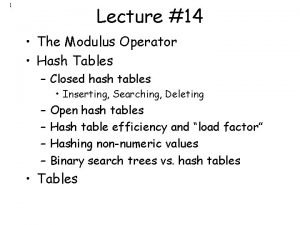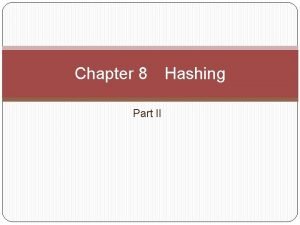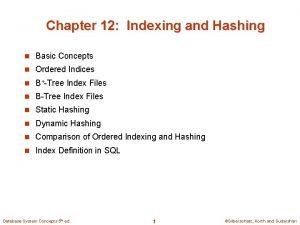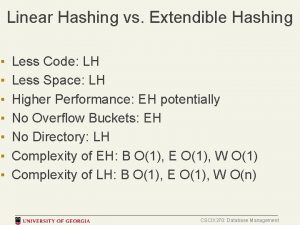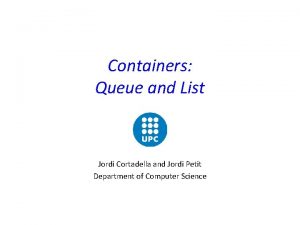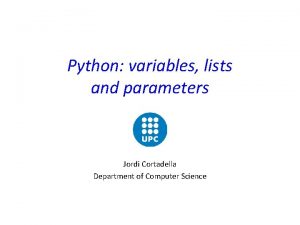Hashing Jordi Cortadella and Jordi Petit Department of




















- Slides: 20

Hashing Jordi Cortadella and Jordi Petit Department of Computer Science

The parking lot • We want to keep a database of the cars inside a parking lot. The database is automatically updated each time the cameras at the entry and exit points of the parking read the plate of a car. • Each plate is represented by a free-format short string of alphanumeric characters (each country has a different system). • The following operations are needed: – Add a plate to the database (when a car enters). – Remove a plate from the database (when a car exits). – Check whether a car is in the parking. • Constraint: we want the previous operations to be very efficient, i. e. , executed in constant time. (This constraint is overly artificial, since the activity in a parking lot is extremely slow compared to the speed of a computer. ) Hashing © Dept. CS, UPC 2

Naïve implementation options • Hashing © Dept. CS, UPC 3

Hashing Plates Hash function Hash table ? A hash function maps data of arbitrary size to a table of fixed size. Important questions: • How to design a good hash function? • The hash function is not injective. How to handle collisions? Hashing © Dept. CS, UPC 4

Hash function • Hashing © Dept. CS, UPC 5

Hashing the plates: some attempts • Hashing © Dept. CS, UPC 6

Hashing the plates: some attempts • Hashing © Dept. CS, UPC 7

Example of hash function for strings • /** Hash function for strings */ unsigned int hash(const string& key, int table. Size) { unsigned int hval = 0; for (char c: key) hval = 37*hval + c; return hval%table. Size; } Hashing © Dept. CS, UPC 8

Handling collisions • Hashing © Dept. CS, UPC 9

Handling collisions: separate chaining 0 0 1 81 1 4 64 4 5 25 6 36 16 49 9 2 3 7 8 9 (perfect squares mod 10) Hashing © Dept. CS, UPC 10

Handling collisions: using the same hash table • Hashing © Dept. CS, UPC 11

An example • 0 1 2 3 4 5 6 26 93 17 7 8 9 10 31 54 Separate chaining: 77 44 20 55 Linear probing: 0 1 2 3 4 5 6 77 44 55 20 26 93 17 7 8 9 10 31 54 What if we remove 55? Use lazy deletion! Hashing © Dept. CS, UPC 12

Rehashing • Hashing © Dept. CS, UPC 13

Complexity analysis Cases Hashing © Dept. CS, UPC 14

Binary Search Trees vs. Hash Tables Not a clear winner Operation Binary Search Tree Hash Table Not required Required Not required Insertion/Deletion/Lookup Sorted Iteration Hash function Total order Range search Hashing © Dept. CS, UPC 15

Application: data integrity check Hash functions are used to guarantee the integrity of data (files, messages, etc) when distributed between different locations. Different hashing algorithms exist: MD 5, SHA 1, SHA 255, … The probability of collision is extremely low. Hashing © Dept. CS, UPC 16

Application: password verification Security is based on the fact that hashing functions are cryptographic (not reversible). Be careful: there are databases of hash values for “popular” passwords (e. g. , 1234, qwert, Messi 10, Barcelona 92, …). Hashing © Dept. CS, UPC 17

EXERCISES Hashing © Dept. CS, UPC 18

Hash function • Hashing © Dept. CS, UPC 19

All elements different • Hashing © Dept. CS, UPC 20
 Jordi cortadella
Jordi cortadella Linear probing hash table
Linear probing hash table What is static hashing in dbms
What is static hashing in dbms Static hashing and dynamic hashing
Static hashing and dynamic hashing Language telegram
Language telegram Linear hashing
Linear hashing Jordi reviriego
Jordi reviriego Jordi ustrell
Jordi ustrell Jordi benlliure
Jordi benlliure Jordi juanico sabate
Jordi juanico sabate Jordi timmers
Jordi timmers Jordi ayala
Jordi ayala Jordi vives i batlle
Jordi vives i batlle Jordi garcia cehic
Jordi garcia cehic Jordi graells costa
Jordi graells costa Jordi npa
Jordi npa Jordi scene
Jordi scene Cmedium
Cmedium Jordi olivares
Jordi olivares Jordi gisbert
Jordi gisbert Jordi sastre
Jordi sastre

